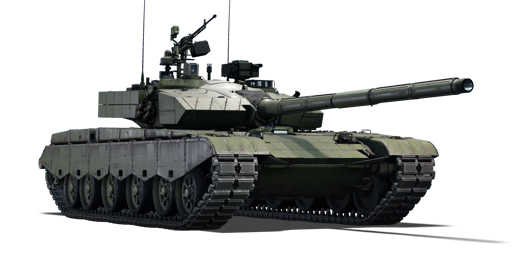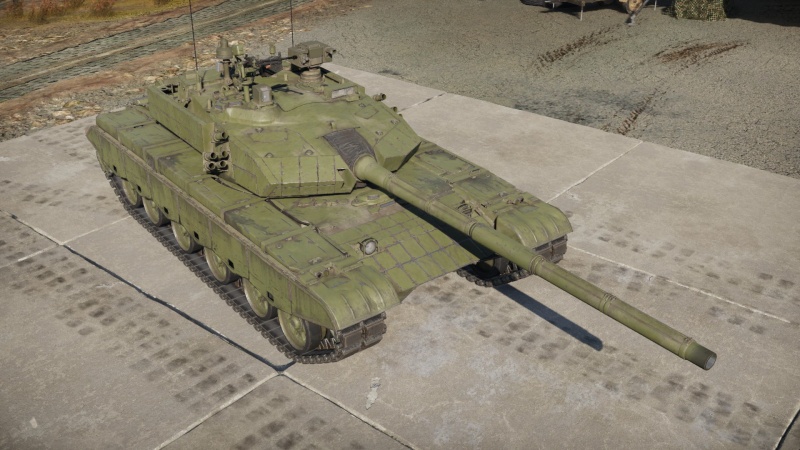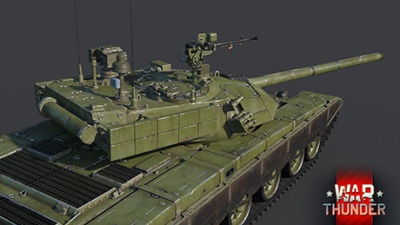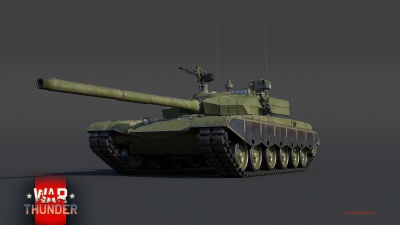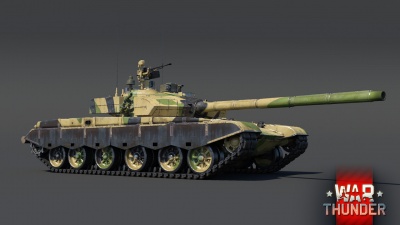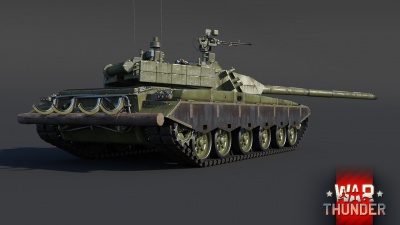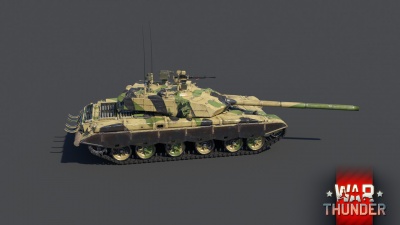ZTZ99-II
| This page is about the Chinese MBT ZTZ99-II. For other versions, see ZTZ99 (Family). |
Contents
Description
The ZhuangJia Tanke ZhuZhan 99 Stage II (ZTZ99式主战坦克 二类定型状态, aka 99一期改; coded WZ123) is the accepted version of the ZTZ99 in PLAGF service since the early 2000s. The plan for a new MBT for the PLAGF arose after the Project 122, which was lacking in firepower against possible Soviet assaults on Mainland China. The project for a new tank was issued in April 1984, and developments during the 1980s included evaluations on Object 172M-1 E-4 (known as T-72 Ural or Type 64 六四型 by Chinese engineers) and later mock-up targets of the T-80U. The standards were revised during development, and the new 3rd generation MBT was tested extensively during the 1990s. The finalized prototypes/LRIP models (ZTZ99-I) were then first shown during the 50th National Day Parade. These LRIP tanks, which were yet to be built at the factory, later received new protection packages in 2004 with FY-4 ERA on both the UFP and turret, leading to the well-known design of the ZTZ99.
The ZTZ99-II was introduced in Update "Hot Tracks". The Chinese adopted a NATO approach for their tank design with arrow-shaped turret applique armour while retaining kinetic ERA protection from Soviet MBTs, into which the engineers integrated the mobility from the former and the firepower from the latter (in fact better than most Russian/Soviet tanks thanks to the ZTZ99's FCS). While design flaws including the driver's hatch, mantlet, LFP and its long hull haunt the tank, the overall better handling compared to Soviet tanks will make players enjoy the overall performance of ZTZ99-II, though they have to maintain extra precaution for the best efficiency.
Note: ZTZ99-II is also erroneously known as Type 99G before the family were clarified by mid-2010s.
General info
Survivability and armour
Like the T-80U, the ZTZ99 uses both composite armour and advanced ERA with kinetic protection. Composite armour is present on the turret cheeks and on the upper glacis; it is unremarkable by itself, but the areas with full coverage of both composite armour and FY-4 ERA are even capable of resisting the Leopard 2A6's DM53 APFSDS. Unfortunately, these areas are limited to the turret cheeks and lower portion of the upper glacis. Interestingly, the ERA is resistant to tandem charge warheads, which allows it to withstand ATGMs that other ERA-equipped vehicles cannot.
Unfortunately, there are plenty of weak spots on the hull. First, the lower glacis has no composite armour or ERA whatsoever and can be penetrated by practically anything, and it also is proportionally larger than on Soviet MBTs. Penetrating shots there have a large chance of detonating the ammo in the autoloader and destroying the tank. The upper glacis composite armour is modeled with a large cutout for the driver's optics, as on the Soviet T-64/72 series, and even the FY-4 ERA there is not enough to save it from powerful APFSDS. Some small portions of the upper glacis are not covered by ERA either.
The turret has its fair share of weak spots as well. The gun mantlet area has no composite armour and penetrating shots will usually take out the gun breech and possibly a crew member. There is a cutout in the ERA array on the left cheek to allow the driver to enter and exit the tank that reduces the protection there. Lastly, this vehicle is an early production ZTZ99 that features a round, cast steel "forehead" on top of the turret, merging into the gunner and commander cupolas. This forehead has inadequate protection against APFSDS rounds and penetrating shots might take out the gunner or commander. Since no ammunition is stored in the turret, frontal turret penetrations will likely only take out one crew member at a time.
The ZTZ99 does not have any ERA on the hull sides and the base hull side armour of 50 mm is thinner than Soviet MBTs, so be careful of IFVs with autocannons. Successful hits to the side will usually total the tank, either detonating the ammo racks or knocking out the turret crew.
The ZTZ99's armour protection has enough gaps that it can be considered "trolly" as opposed to "well-protected", but the areas that are well-protected are very strong. It's best to stay at long range and utilize the ZTZ99's low profile in conjunction with cover to make it difficult for enemies to hit the weak spots. Putting some bushes near the driver's hatch or gun mantlet might help. Remember that ERA is destroyed upon absorbing fire and the composite armour alone does not have sufficient protection for a top-rank vehicle.
As a last note, the GL-7 laser dazzler is physically modeled on the left side of the turret roof, but the active protection capabilities is currently not implemented in War Thunder (while its LWR and laser rangefinding functions are implemented).
Armour type:
- Rolled homogeneous armour (hull, turret cheeks, turret roof, cupolas)
- Cast homogeneous armour (turret, gun mantlet, driver hatch)
- Rubber-fabric screens (side skirts)
- Structural steel (slat armour)
| Armour | Front (Slope angle) | Sides | Rear | Roof |
|---|---|---|---|---|
| Hull | 20 mm (70°) Upper front 80 mm (60°) Lower front |
80 mm (50°) Top 20 mm Bottom |
45 mm | 20-30 mm |
| Turret | 220 mm Turret front 310 mm Gun mantlet |
80 mm (volumetric) | 35 mm | 30-50 mm |
| Cupola | 45 mm (cylindrical) | 35 mm | ||
| Composite armour | Frontal effective protection |
|---|---|
| Hull | Upper glacis (ERA counted): 500-850 mm Kinetic / 700-1300 mm Chemical |
| Turret | Turret front (ERA counted): 400-700 mm Kinetic / 400-1200 mm Chemical Gun mantlet: 30-400 mm Kinetic / 60-400 mm Chemical |
| FY-4 Explosive reactive armour | Front (Slope angle) | Sides |
|---|---|---|
| Hull | Upper glacis: 140 mm Kinetic/ 450 mm Chemical |
|
| Turret | Turret front: 140 mm Kinetic/ 450 mm Chemical |
Rear side: 50 mm Kinetic / 350 mm Chemical |
Notes:
- Suspension wheels, tracks, and torsion bars are 20 mm thick.
- Side skirts are 8 mm thick, and slat armour on the turret sides is 10 mm thick.
- A log placed at the rear of the hull is 100 mm thick.
Mobility
| Game Mode | Max Speed (km/h) | Weight (tons) | Engine power (horsepower) | Power-to-weight ratio (hp/ton) | |||
|---|---|---|---|---|---|---|---|
| Forward | Reverse | Stock | Upgraded | Stock | Upgraded | ||
| Arcade | Expression error: Unexpected * operator. | 1860 | Expression error: Unexpected round operator. | __.__ | |||
| Realistic | 1061 | Expression error: Unexpected round operator. | __.__ | ||||
The ZTZ99-II's mobility is average for a top-tier vehicle. It has a sizeable NORINCO Shanxi Diesel 12V150HB 1,200 hp diesel engine, which is comparable to the T-80U's Klimov GTD-1250 1,250 hp gas turbine engine and among the most powerful Eastern Bloc diesel engines, despite its design limits from the chassis. However, the ZTZ99 also weighs at 51 tons, which approaches the weight of the Leopard 2A4 and the M1 Abrams. Among contemporaries, its power-to-weight ratio is better than the Challenger 2 and T-72B3 mod. 2011 (before the 2016 UBH upgrades), comparable to the Ariete PSO and M1A2 Abrams. Though it is quite fast in a straight line, reaching 65 km/h on road at most; this 51-ton tank does need a considerably long time to pick up speed especially when stock or traversing rough terrain. Also, due to the space limits of the chassis and lack of manufacturing experience with transmission boxes, it has no neutral steering and the reverse speed with a mere -5 km/h is truly abysmal. The ZTZ99 can get into battle reasonably quickly but does not excel at flanking and will struggle to retreat from sticky situations, so avoid over-extending into the battlefield to keep the tank in one piece.
Modifications and economy
Recommended research order:
- Parts. The ZTZ99-II's gun mantlet is a major weak spot meaning the gun breech or barrel can get destroyed a lot. Being able to repair these critical components is crucial.
- 125-I APFSDS. Stock HEAT rounds are a pain to use against modern MBTs, while the HE requires longer time to target the enemy's weak spot, putting the ZTZ99-II in danger. A filler APFSDS allows more weak spots to be an option.
- Mobility modifications. They can improve the tank's speed and handling.
- LWS/LR. The more important module here is the laser rangefinder as it allows the player to quickly target distant enemies. The laser warning receiver is a nice bonus.
- DTC10-125 APFSDS. With 500+ mm penetration, this round renders even more areas as penetrable, greatly increasing the ZTZ99-II's capacities.
- Others
Armaments
Main armament
The ZPT98 cannon is a 125 mm smoothbore cannon with an autoloader, much like the 2A46 cannon used by the T-72 or the Type 88C cannon used by the ZTZ96, but it is 50 calibres long instead of 48. The reload speed of 7.1 seconds is the slowest of any top-rank vehicle, so destroying or crippling enemies in one shot is important; but thanks to the upgraded FCS, ZTZ99-II can be more versatile with 6x-11x gun optics, helping players to engage both close and long range targets with relative ease. The gun handling is the same as the ZTZ96 series, being slightly better than most Soviet MBTs barring the T-80U and comparable to certain Western bloc MBTs (Challenger 2, Leclerc, Type 10 etc.).
| 125 mm ZPT98 | Turret rotation speed (°/s) | Reloading rate (seconds) | ||||||||
|---|---|---|---|---|---|---|---|---|---|---|
| Mode | Capacity | Vertical | Horizontal | Stabilizer | Stock | Upgraded | Full | Expert | Aced | Autoloader |
| Arcade | 39 | -5°/+13° | ±180° | Two-plane | 28.6 | 39.5 | 48.0 | 53.1 | 56.5 | 7.10 |
| Realistic | 17.9 | 21.0 | 25.5 | 28.2 | 30.0 | |||||
Ammunition
| Penetration statistics | |||||||
|---|---|---|---|---|---|---|---|
| Ammunition | Type of warhead |
Penetration @ 0° Angle of Attack (mm) | |||||
| 10 m | 100 m | 500 m | 1,000 m | 1,500 m | 2,000 m | ||
| DTP-125 | HEATFS | 480 | 480 | 480 | 480 | 480 | 480 |
| DTB-125 | HE | 45 | 45 | 45 | 45 | 45 | 45 |
| 125-I | APFSDS | 466 | 464 | 458 | 450 | 442 | 434 |
| DTC10-125 | APFSDS | 577 | 575 | 566 | 555 | 544 | 533 |
| GP125 | ATGM (tandem) | 850 | 850 | 850 | 850 | 850 | 850 |
| DTB12-125 | HE-VT* | 43 | 43 | 43 | 43 | 43 | 43 |
| Shell details | ||||||||||||
|---|---|---|---|---|---|---|---|---|---|---|---|---|
| Ammunition | Type of warhead |
Velocity (m/s) |
Projectile mass (kg) |
Fuse delay (m) |
Fuse sensitivity (mm) |
Explosive mass (TNT equivalent) (kg) |
Ricochet | |||||
| 0% | 50% | 100% | ||||||||||
| DTP-125 | HEATFS | 905 | 18 | 0.05 | 0.1 | 2.62 | 65° | 72° | 77° | |||
| DTB-125 | HE | 850 | 23 | 0.3 | 0.1 | 5.46 | 79° | 80° | 81° | |||
| 125-I | APFSDS | 1,730 | 4.02 | - | - | - | 78° | 80° | 81° | |||
| DTC10-125 | APFSDS | 1,770 | 4.85 | - | - | - | 78° | 80° | 81° | |||
| Missile details | ||||||||||||
|---|---|---|---|---|---|---|---|---|---|---|---|---|
| Ammunition | Type of warhead |
Velocity (m/s) |
Range (m) |
Projectile mass (kg) |
Fuse delay (m) |
Fuse sensitivity (mm) |
Explosive mass (TNT equivalent) (kg) |
Ricochet | ||||
| 0% | 50% | 100% | ||||||||||
| GP125 | ATGM (tandem) | 445 | 5,000 | 17.2 | 0.4 | 0.01 | 5.72 | 80° | 82° | 90° | ||
| Proximity-fused shell details | ||||||||||||
|---|---|---|---|---|---|---|---|---|---|---|---|---|
| Ammunition | Type of warhead |
Velocity (m/s) |
Projectile mass (kg) |
Fuse delay (m) |
Fuse sensitivity (mm) |
Arming distance (m) |
Trigger radius (m) |
Explosive mass (TNT equivalent) (kg) |
Ricochet | |||
| 0% | 50% | 100% | ||||||||||
| DTB12-125 | HE-VT* | 850 | 23.2 | 0.3 | 0.1 | 500 | 7 | 5.3 | 79° | 80° | 81° | |
Reload time aside, the ZTZ99's firepower is good, where its variety of ammunition can help players defeat all types of enemies.
The stock DTP-125 HEATFS round has the typical penetration of 480 mm shared by Western MBTs with 120 mm guns, but this is not enough to deal with tanks with composite armour, which are the norm at the ZTZ99's battle rating. The post-penetration damage is also disappointing. Only use it as an interim shell before APFSDS is unlocked. With 2.19 kg of explosive mass, it is sometimes capable of knocking out light targets like SPAAs and light tanks with overpressure damage, so keep an eye out for those.
The stock DTB-125 HE shell is one of the strongest of any top-rank MBT. It can actually cause more damage to MBTs than the HEATFS round if fired at turret rings, hull roofs, and turret cupolas, especially after the introduction of pressure damage. Well placed impacts have a good chance of transmitting the shockwave into the crew compartment and knocking the target out instantly, even against the toughest MBTs like the Leopard 2A6. It helps to keep a few HE rounds around even after APFSDS is unlocked as they excel at causing pressure damage to light targets.
The ZTZ99-II also has access to the GP125 tandem ATGM, which performs identically to its Soviet counterpart. If players find their darts are not effective against well-armoured targets, the sufficient velocity and penetration can ruin the day of such vehicles, as well as helicopters if they don't evade the incoming missile.
The 125-I APFSDS round is a tier 1 modification. Though it first appeared on the ZTZ96, it is still a decent option for the ZTZ99 and eases the stock grind considerably. It has very similar flat penetration and superior angled penetration to the 3BM42 "Mango" round used by Soviet tanks and can penetrate most contemporary opponents through at least the lower front plate and gun breech.
Waiting as a tier 4 modification is the DTC10-125 APFSDS round, a high mass and high velocity shell with only slightly worse performance compared to 3BM60 on the T-80BVM. This will be the go-to round for the ZTZ99-II and most targets at the rank are unlikely to withstand a penetrating shot from this shell.
DTB12-125 is also available as a tier 4 modification; this is one of the few HE-VT shells available for a top-tier MBT. This shell turns ZTZ99-II into a 125 mm anti-aircraft gun thanks to its generous explosive filler, any aircraft that are within its 7 m trigger radius will not have a good day. Although it has lesser explosive content, the VT fuse is not triggered by ground vehicles so it can serve as an alternative to the stock HE-FS as well.
Ammo racks
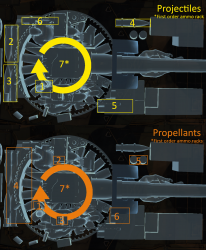
| Full ammo |
Ammo part |
1st rack empty |
2nd rack empty |
3rd rack empty |
4th rack empty |
5th rack empty |
6th rack empty |
7th rack empty |
Visual discrepancy |
|---|---|---|---|---|---|---|---|---|---|
| 39 | Projectiles Propellants |
37 (+2) 39 (+0) |
34 (+5) 38 (+1) |
31 (+8) 37 (+2) |
27 (+12) 28 (+11) |
23 (+16) 26 (+13) |
N/A 23 (+16) |
1 (+38) 1 (+38) |
No |
Notes
- The 7th projectiles and propellants rack is the First-stage ammo stowage: it is a mechanized ammo rack with a fixed reload rate.
- The mechanized ammo rack depletes clock-wise: the arrow in the image shows where the ammo depletion starts.
- It is recommended to bring 23 rounds in the tank as to limit the chances of the tank being knocked out by ammo rack explosion.
Machine guns
| 12.7 mm QJC88A | ||||
|---|---|---|---|---|
| Mount | Capacity (Belt) | Fire rate | Vertical | Horizontal |
| Pintle | 600 (150) | 600 | -6°/+85° | ±180° |
| 7.62 mm Type 86 | ||||
|---|---|---|---|---|
| Mount | Capacity (Belt) | Fire rate | Vertical | Horizontal |
| Coaxial | 2,500 (250) | 700 | - | - |
Usage in battles
Thanks to the technological advancements of the early 2000s, the ZTZ99-II shares a similar FCS to its (tech tree) predecessor ZTZ96A with variable 6x-11x magnification for the gunner's optics, and up to 10.7x magnification for the CITV, both equipped with TVD. This helps with engaging targets over ridge lines- commander override is a viable choice in case of long-range engagement. Thanks to its powerful 12V150HB engine, the ZTZ99 can accelerate fast enough to follow the team or alternatively, go to mid-field sniping positions. The laser warning system and high-quality thermal sights for the commander give the ZTZ99 a large degree of situational awareness, allowing enemies to be spotted and engaged quickly.
A reminder to ZTZ99's protection: always point the hull exactly at the enemies to increase the odd of survival; the disappointing side protection and a huge fuel tank means any penetrated side-shots, at even the slightest angle, can send it straight back to the hanger.
Try to attack enemies from a distance and while they are in the open; in this situation they will have difficulty targeting the weak points of the ZTZ99 while the ZTZ99 typically only needs to shoot their hull when using the top DTC10-125 APFSDS. The DTB12-125 HE-VT and GP125 tandem ATGM are also at your disposal in case of any incoming aircraft or more sturdy targets. Be aware of the slow reload, which is up to 50% slower than other top MBTs. If a target is still capable of returning fire after being hit (e.g. gunner, commander, gun breech, turret drive are functional), it might be better to move to cover and wait for teammates to distract or attack them. Move up when the coast is clear but do not overextend, it is difficult to back out from a bad position due to the bad reverse speed and in the meantime enemies can fire plenty of shots at the ZTZ99. Although it has the sufficient mobility to keep up with the team, it is not a good idea to use ZTZ99 as any kind of brawler, especially in urban maps - the subpar turn rate of both the turret and hull can be the reason of your demise despite its frontal arc protection.
Assault Mode:
For top rank main battle tanks, it is essential to grind out critical modules such as APFSDS and thermal optics prior to joining PvP battles, and the Assault mode is a great choice for this. If you have played assault to unlock the preceding ZTZ96A's modules, a stock ZTZ99 will behave familiarly or even better in some aspects. It is noticeably faster and better protected, allowing you to get to positions quicker and take hits frontally without being destroyed too soon. Before spawning in, consider bringing full ammo load so you can fight longer, with half HEAT and half HE shells. Map knowledge specifically for assault can greatly increase your survivability and targets destroyed, so memorise some good spots where you can deal with threats from only one direction and has hard covers. As the countdown goes at the start of the match rush to one of such spot.
In the early stages of an assault battle, there will be waves of light tanks/cold war tanks that can be easily knocked out with your HEAT shells. Note that regardless of the era of AI tanks, you want to hide your lower front plate as much as possible, since the AI can precisely target such weak spots across the map and detonate the ZTZ99's ammo. Needless to say, the ZTZ99 can confidently resist almost all AI gun fires from the front, but do not angle too much, the side armour is extremely thin. The gun mantlet is also a weak spot that can lead to your gun breech being destroyed.
As the match progresses, waves of modern main battle tanks will show up, some of which can still get destroyed by your HEAT (e.g. M1A2), but well protected ones will require HE to do the job (e.g. Leopard 2A5, Challenger 2 (2F)). Scan the target and fire HE at where the crosshair turns green, the HE can usually detonate random ammo inside the AI tanks. The ZTZ99's reload of 7.5 seconds may feel slow when facing huge amount of AI waves, so do not forget to fire your MG at their tracks, gun barrels, etc. This will not necessarily deal any damage however will give you assists when the AI is destroyed by other teammates, which means more scores thus more research points. Before the next wave shows up, you can go to any nearby repair spots to instantly repair and rearm. However if you are immobilised and disarmed and do not have "Parts" researched, or set on fire without any FPE, bail out and spawn in a new ZTZ99 to avoid wasting time.
Pros and cons
Pros:
- Powerful firepower:
- Variety of shells ranging from high-penetration darts, devastating HE(-VT) shells and gun-launched ATGM
- High resolution thermal sights for both commander and gunner give it some advantage in poor visibility conditions
- Autoloader reloads the cannon even when putting out fires or replacing crew members
- Roof-mounted heavy machine gun is useful against low-flying aircraft and light targets
- Good armour:
- Nice frontal protection: sturdy turret cheeks and upper front plate, can resist common shells
- ERA is immune to tandem-charged warheads
- Low profile
- Has a laser warning receiver
- Improved mobility over preceding ZTZ96A with faster acceleration and higher top speed
Cons:
- Inconsistent protection:
- Has a huge driver's weak spot that can be penetrated by pretty much any gun
- Weak gun mantlet, very easy to disable gun breech
- The outer part of the mantlet are in fact armour sheets rather than ERA, lowering its thickness significantly
- Lower plate is very weak, with penetrating shells incapacitating the crew or exploding ammo
- The bulge part of the turret (cast armour) might sometimes be penetrated and causing gun damages
- Poor mobility:
- Ineffectual reverse speed of only -5 km/h, makes it difficult to reverse and repair or escape dangerous situations
- Due to the long hull, hull traverse speed is slow especially when stock or on loose surfaces
- Turret ERA offers low KE protection
- Only 3 crew members
- Poor gun depression of -5° limits its capacity in hilly environments
- Relatively slow reload of 7.1 seconds compared to other MBTs
History
In the late 1960s, Mainland China had found that the PLAGF was lagging behind the mainstream of MBTs of the era; the menacing Soviet armoured brigades in the Far East were also a great concern as well, especially after Damansky (Zhenbao) Island Incident where they captured a T-62. During the mid-1970s, the Commission for Science, Technology and Industry for National Defense (COSTIND 国防科学技术工业委员会) made a few attempts to design new MBTs under the code WZ122 with multiple prototypes; technological issues put an end to those prototypes in the mid-1970s.
Soon after the Cultural Revolution, in April 1978, COSTIND and 5th Ministry of Machine Building (第五机械工业部, now NORINCO and CSGC) received the requirements from PLA for a modern MBT, known as Project 784. It was to weigh around 43 tons and be armed with a 120 mm gun, as well as sporting a 1,000 hp MTU MB 331 TC-41 engine (which only 10 of them were imported from West Germany), in view of competing with the latest West German Leopard 2 MBTs with excellent firepower and mobility. This prototype tank, coded WZ1224 underwent intensive tests. Later in 1984, Chinese exchanged a T-72 Ural from Romania, naming it Type 64 and using it for evaluation.[1] Although it was a fantasy for Mainland China during the 1980s to build a top-notch MBT, WZ1224, along with its later prototypes, became the basis of a new MBT - what would become the WZ123.
In the mid-1980s, after the Leopard 2-like design and Merkava-like design were ditched due to their overall inferior protection (Leopard 2 was too huge while a front-placed engine in fact decreased the overall protection against kinetic shells, as stated in research papers), COSTIND decided that WZ123 should have a low profile like a T-72 and Zhu Yusheng (祝榆生, Nov 1918 - 23 Oct 2014) of Institute 201 (201所,北方车辆研究所) would be the chief designer of WZ123. During the decade between 1980s and 1990s, the new MBT went through extensive tests, including choosing a suitable engine for the tank at 1,200 hp, aimed to be comparable to the top-notch western MTU MB 873 Ka-501. However, the Chinese could only manage to get the license for MB 396 (a marine engine, Type 212 submarines used a pair of them; the licensed MTU 396 engine became the backbone of PLAN's new DDGs), and reverse-engineering efforts on the previous MB 331 TC-41 became 8V165 (8 valve, 165 mm cylinder diameter) with major flaws, so the options were only limited to domestic X150 or 150HB (designated by the cylinder diameter in millimetres) engine from Institute 70 (NORINCO China North Engine Research Institute; Datong, Shanxi) and the lineage to German technology ended. A requirement from COSTIND was that the tank was to be compact, so large size engines like MB 873 Ka-501 weren't a viable option for the new MBT. With only 946 hp and some flaws found during the fitting of new engines into WZ123, the more potent and viable option in terms of Mainland China's overall engine technology: 150HB engine designed by Zhang Baozhong (张保中) was chosen as WZ123's engine.[2] Later in 1996, Factory 617 (NORINCO Inner-Mongolia First Machinery Group Corporation) delivered the new 3rd generation MBT to PLAGF for tests. While all the tests showed that WZ123 had passed the requirements from PLAGF, it was very unlikely made the way into commission before the 50th Anniversary of the Establishment of PRC under the codename "Project 9910"; efforts were made so that Factory 617 could produce 18 of these tanks to be paraded in the anniversary as the C001 to C018 tanks of C-vehicle phalanx, it was then known as Type 98 by USDOD. The prototypes built for Project 9910, aka ZTZ99-I then served in 38th Army Corps and based on this design, in early 2000s, Factory 617 built 2 variants of them for theorizing the applique and ERA placement of WZ123; finally one of them passed state certification at around 2003 and became ZTZ99-II (or ZTZ99 Mod. 2003, 99一期改, ZTZ99 "二类定型状态" in-game; erroneously known as 99G).
This design was then revised and finally in the 60th Anniversary of the Establishment of PRC, a new version named ZTZ99-III (or ZTZ99 Mod. 2004, 99二期改, ZTZ99 "三类定型状态" in-game; erroneously known as 99A1) was first publicly shown with a revised turret and placement of FY-4 ERA on the UFP. During the first decade of the 21st century, NORINCO was also refining their revised design on ZTZ99, dubbed ZTZ99AY (Y for 验证, proof of concept). A decade later, in the 70th Anniversary of Victory over Japan Day, a brand-new designed ZTZ99A (erroneously known as 99A2), designed by Mao Ming (毛明, Sept 1962-) was first shown to the public, which only nominally shared the ZTZ99 name, and had enhanced capabilities against any modern and future MBTs it might face, serving as the new spearhead of elite armoured brigades in northern China.
Devblog
Development of the ZTZ99 began in the mid 1980s, with Chinese engineers starting work on a new advanced main battle tank to replace the existing vehicles in service at the time. After examining possible design proposals, the engineers decided to proceed with a design similar to that of the Soviet T-72 tank.
By 1991, the first prototype of the vehicle was constructed and demonstrated to high-ranking officials, followed by the construction of additional prototypes in the following year. In the early to mid 1990s, the prototypes underwent testing and were continuously improved over time. In the late 1990's, further pre-production prototypes were built and transferred to the army for final testing.
The ZTZ99 was first shown off to the public as part of the military parade commemorating the 50th anniversary of the People's Republic of China in October 1999. Soon after, the ZTZ99 was officially adopted for service with the PLA in late 2000.
Several years after its first introduction to service, the ZTZ99 received an upgrade package, allowing the vehicle to be fitted with additional FY-4 ERA, thus bolstering its protection significantly. Although initially intended to become China's primary MBT, the high cost hindered large-scale production, resulting in only about 500 vehicles being manufactured. However, due to the tank's advanced design and relatively small numbers, ZTZ99s are exclusively employed by China's elite armoured units.
The ZTZ99 remained in production until the early 2010s, before production capacities were allocated to the more advanced ZTZ99A - a highly modernized variant of the ZTZ99.
Media
- Skins
Skins and camouflages for the ZTZ99-II from live.warthunder.com.
- Images
- ZTZ99 Devblog Images
- Videos
See also
Links to the articles on the War Thunder Wiki that you think will be useful for the reader, for example:
- reference to the series of the vehicles;
- links to approximate analogues of other nations and research trees.
External links
References
| Norinco (China North Industries Corporation) | |
|---|---|
| Light AFV/IFV | |
| WZ501 | ZBD86¹ |
| WZ131 | ▂Type 62 · Type 62 |
| WZ211 | Type 63 · ZTS63 |
| WZ502 | ZBD04A |
| MBT | |
| WZ120 | Type 59¹ · ZTZ59A · ZTZ59D1 |
| WZ121 | Type 69 |
| WZ122 | ZTZ88B · ZTZ88A · ZTZ96 · ZTZ96A · ZTZ96A (P) |
| WZ123 | ZTZ99-II · ZTZ99-III |
| WZ1001 | WZ1001(E) LCT · ZTZ99A |
| Tank Destroyers | AFT09 · PTL02 · PTZ89 · ZLT11 |
| SPH | PLZ83 |
| SPAA | ZSD63/PG87² · PGZ09 · PGZ04A |
| Export | |
| WZ121 | Type 69-IIa · T-69 II G |
| MBT2000 | MBT-2000 · Al-Khalid-I |
| MBT3000 | VT4A1 |
| Other | WMA301 · WZ305 |
| ¹ License production / Reverse engineered · ² Field modifications | |
| China medium tanks | |
|---|---|
| ZTZ59 | Type 59 · ZTZ59A · ZTZ59D1 |
| ZTZ69 | Type 69 · Type 69-IIa |
| ZTZ88/96 | ZTZ88A · ZTZ88B |
| ZTZ96 · ZTZ96A · ZTZ96A (P) | |
| ZTZ99 | ZTZ99-II · ZTZ99-III |
| ZTZ99A | ZTZ99A · WZ1001(E) LCT |
| Export series | MBT-2000 · VT4A1 |
| ROC | CM11 |
| Other | Т-34-85 Gai · Object 122MT "MC" |
| Bangladesh | T-69 II G |
| Japan | ␗Chi-Ha · ␗Chi-Ha Kai |
| Pakistan | Al-Khalid-I |
| USA | ␗M4A4 · ␗M4A4 (1st PTG) · ␗M4A1 (75) W · ␗M48A1 · ␗M60A3 TTS |
| USSR | ␗T-34 (1943) · ␗Т-34-85 (S-53) · T-34-85 No.215 · Т-62 №545 |


